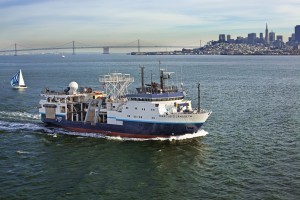The R/V Marcus G. Langseth: Ocean Explorer
The Marcus G. Langseth, a research vessel operated by Lamont-Doherty Earth Observatory, traverses the world’s oceans conducting marine seismic studies that contribute to new understanding of Earth systems. The ship typically spends half the year or more on research expeditions led by Lamont-Doherty scientists and colleagues from other research institutes.

The Marcus G. Langseth, a research vessel operated by Lamont-Doherty Earth Observatory, traverses the world’s oceans conducting marine seismic studies that contribute to new understanding of Earth systems. The ship typically spends half the year or more on research expeditions led by Lamont-Doherty scientists and colleagues from other research institutes.
Mentions of cruises may conjure up images of mammoth floating hotels and lounge chairs, but the cruises undertaken by earth scientists involve neither of those. Researchers who examine the seismic activity taking place beneath the sea can spend many weeks each year aboard ships deploying instruments and collecting data; these cruises often involve long days working in all manner of sea conditions.
At the American Geophysical Union (AGU) fall meeting, now taking place in San Francisco, scientists and students who use the Langseth for research expeditions, the ship’s operators and administers from Lamont-Doherty and the University-National Oceanographic Laboratory System (UNOLS), and National Science Foundation program managers, met on Dec. 8 for the Marcus Langseth Science Oversight Committee annual community meeting.
At AGU, the oversight committee’s goal was to review results of the ship’s recent expeditions and discuss future research cruises. This year, for the first time, the meeting included a young career scientists workshop, where graduate students and early career investigators who have worked aboard the Langseth gave short talks about their research. Lamont-Doherty presenters included graduate students Natalie Accardo, James Gibson and Shuoshuo Han; postdoctoral researcher Nathan Miller; associate research scientist Angela Slagle; and alum Danielle Sumy (Ph.D. ’11).

Their talks were followed by presentations by scientists on the Langseth’s recent and upcoming cruise activities. Highlights included a talk by paleoclimatologist Pratigya Polissar, who discussed his May 2012 cruise near the Line Islands in the central equatorial Pacific. Scientists on this cruise collected nearly 500 feet of sediment cores, which are being analyzed and used to gain new insight into the alternating El Niño and La Niña weather patterns that affect much of the globe. The oldest core recovered on Polissar’s expedition dates back more than 400,000 years, covering the last three glacial cycles.
Marine geophysicist Fernando Martinez (Ph.D. ’88) from the University of Hawai’i at Manoa reported on a cruise that he led to the Reykjanes Ridge in the North Atlantic Ocean in August 2013. The goal of the month-long cruise was to collect multibeam, magnetics and gravity data that will inform understanding of the evolution of the Reykjanes Ridge, a segment of the Mid-Atlantic Ridge just south of Iceland. This data will be used to test competing theories about what’s happening in this geologically fascinating area, with important implications for our understanding of geodynamic processes in the Earth.
Marine geophysicist Donna Shillington described a new research initiative that will use the Langseth to acquire large geophysical datasets in Atlantic waters as part of the Geodynamic Processes at Rifting and Subducting Margins (GeoPRISMS) project. The ultimate goal of GeoPRIMS is to investigate the coupled geodynamics, earth surface processes and climate interactions that build and modify continental margins over a wide range of timescales. The data Shillington and her group obtain during an upcoming cruise aboard the Langseth will be made available to the scientific community for various studies of the deep structure of the Eastern North Atlantic Margin. The project is also unique in that it features a large education and outreach component, which will train students and early career scientists to acquire and analyze seismic data.
The Langseth is scheduled to undergo maintenance in early 2014 before spending the remainder of the year on expeditions in the North Atlantic, including the GeoPRISMS cruise.
Visit the Marine Operations section of the Lamont-Doherty website to learn more about the R/V Langseth and the Observatory’s long history of seagoing exploration and discovery.
